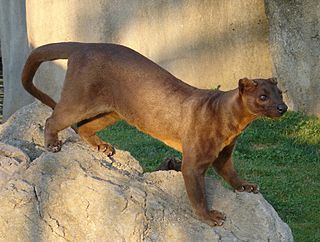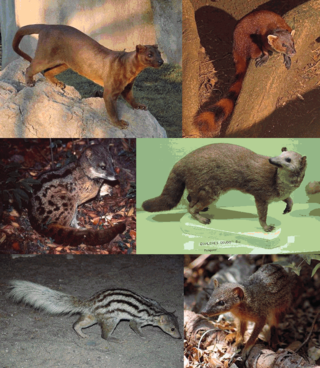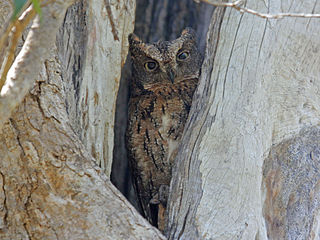
A tenrec is any species of mammal within the afrotherian family Tenrecidae, which is endemic to Madagascar. Tenrecs are a very diverse group; as a result of convergent evolution some resemble hedgehogs, shrews, opossums, rats, and mice. They occupy aquatic, arboreal, terrestrial, and fossorial environments. Some of these species, including the greater hedgehog tenrec, can be found in the Madagascar dry deciduous forests. However, the speciation rate in this group has been higher in humid forests.

Elephant birds are extinct flightless birds belonging to the order Aepyornithiformes that were native to the island of Madagascar. They are thought to have become extinct around 1000 AD, likely as a result of human activity. Elephant birds comprised three species, one in the genus Mullerornis, and two in Aepyornis.Aepyornis maximus is possibly the largest bird to have ever lived, with their eggs being the largest known for any amniote. Elephant birds are palaeognaths, and their closest living relatives are kiwi, suggesting that ratites did not diversify by vicariance during the breakup of Gondwana but instead convergently evolved flightlessness from ancestors that dispersed more recently by flying.

Lemurs are wet-nosed primates of the superfamily Lemuroidea, divided into 8 families and consisting of 15 genera and around 100 existing species. They are endemic to the island of Madagascar. Most existing lemurs are small, have a pointed snout, large eyes, and a long tail. They chiefly live in trees and are active at night.

The paradise flycatchers (Terpsiphone) are a genus of birds in the family Monarchidae. The genus ranges across Africa and Asia, as well as a number of islands. A few species are migratory, but the majority are resident. The most telling characteristic of the genus is the long tail streamers of the males of many species. In addition to the long tails the males and females are sexually dimorphic and have rufous, black and white plumage.

The fossa is a slender, long-tailed, cat-like mammal that is endemic to Madagascar. It is a member of the carnivoran family Eupleridae.

The fauna of Madagascar is a part of the wildlife of Madagascar.

Eupleridae is a family of carnivorans endemic to Madagascar and comprising 10 known living species in seven genera, commonly known as euplerids, Malagasy mongooses or Malagasy carnivorans. The best known species is the fossa, in the subfamily Euplerinae. All species of Euplerinae were formerly classified as viverrids, while all species in the subfamily Galidiinae were classified as herpestids.

Chrysiridia rhipheus, the Madagascan sunset moth, is a species of day-flying moth of the family Uraniidae. It is considered one of the most impressive and appealing-looking lepidopterans. Famous worldwide, it is featured in most coffee table books on Lepidoptera and is much sought after by collectors, though many older sources misspell the species name as "ripheus". The colours originate from optical interference in the iridescent parts of the wings, while the black parts are pigmented. Adults have a wingspan of 7–9 cm (2.8–3.5 in).

The Anjajavy's Protected Area is located on a peninsula of the town of Antonibe, in the district of Analalava and in the north-west region of Madagascar. It is part of the Sofia region of the independent province of Mahajanga and its position is between 47°13’ at 44°22’ of longitude east and 14°58 at 15°07’ of latitude south..

The Marianne white-eye, also known as Seychelles chestnut-sided white-eye or Seychelles yellow white-eye, is an extinct species of small bird in the white-eye family.

Mud-puddling, or simply puddling, is a behaviour most conspicuous in butterflies, but also occurring in other animals, primarily insects. The organism seeks out nutrients in certain moist substances such as rotting plant matter, mud and carrion, and suck up the fluid. Where the conditions are suitable, conspicuous insects such as butterflies commonly form aggregations on wet soil, dung or carrion. From the fluids they obtain salts and amino acids that play various roles in their physiology, ethology and ecology. This behaviour also has been seen in some other insects like the leafhoppers, e.g. the potato leafhopper, Empoasca fabae.

The reddish-gray mouse lemur also known as the gray-brown mouse lemur or rufous-gray mouse lemur, is a small, solitary-but-social, nocturnal and omnivorous primate from the Western Madagascar in the region around Beza Mahafaly Reserve, north to Lamboharana. Like the other lemur species, the reddish-grey mouse lemur is endemic to Madagascar. They generally live in the drier regions of the island. It is categorized as least concerned in the IUCN Red List.

Coquerel's coua is a species of cuckoo in the family Cuculidae. It is endemic to Madagascar. Its habitat is subtropical or tropical dry forests. It was named in 1867 by the French naturalist Alfred Grandidier in honor of the French navy surgeon and naturalist Charles Coquerel.

The Madagascar scops owl, also known as the Malagasy scops owl or Rainforest scops owl, is a species of owl in the family Strigidae. It is found throughout Madagascar, now that is has recently been lumped with the Torotoroka scops owl, with which it was long considered a separate species from. The nominate O. r. rutilus is referred to as Rainforest scops owl.

The Malagasy sacred ibis is a relatively large, heavily built ibis endemic to the west coast of Madagascar, and Aldabra on the Seychelles.

The Malagasy paradise flycatcher is a species of bird in the family Monarchidae. It is found in Comoros, Madagascar, and Mayotte. Its natural habitats are subtropical or tropical dry forest and subtropical or tropical moist lowland forest.
Hemiceratoides is a genus of moths of the family Erebidae.

Borocera cajani, also known as landibe in Malagasy, is a species of silk-producing lasiocampid moth endemic to Madagascar. It is often confused with the similar Borocera madagascariensis, which has the same Malagasy name. However, B. cajani is the species associated with silk production in highland Madagascar, while B. madagascariensis is found in the coastal portion of the island.
















